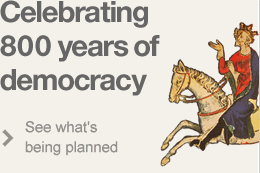The names of the twenty-five barons elected as sureties or guarantors of Magna Carta are now part of the historical record. Their lives and achievements have been well documented and, rightly or wrongly, many people proudly claim descent from them. Yet these men were very much a product of their unruly times. They were the aristocratic elite of Anglo-Norman society, holding large swathes of land from the king, particularly in the North of England and East Anglia.
Each baron had at least one barony that was made up of a number of fees or manors, and one manor in particular was the caput honoris, the chief manor. As lord of this manor, the baron had a strong influence on the lives of the ordinary people – his vassals – who worked on his demesne or rented land to farm. Eight centuries later, few if any of the barons’ descendants are directly associated with the communities that developed on their chief manors. Instead, what we see today are towns and villages formed by generations of residents who spent their lives working in the same fields, living in the same houses, attending services in the same parish church and buried in the same cemetery. They and their descendants may well have been paying rent to the same baron’s family for hundreds of years!
The anniversary of Magna Carta is providing today’s residents of these towns and villages a unique opportunity to jointly celebrate their history. Some are still tiny – Huntingfield has less than 200 residents – but others have grown to the size of a city. The chief manor of Saher de Quincy was Leicester, which now has over 300,000 residents. That of Geoffrey de Saye was West Greenwich and is part of the Royal Borough of Greenwich in London. When their parish and town council representatives convened at the site of the high altar at the abbey of St Edmundsbury in May 2013, it was the first time since their barons had met there in November 1214 to plan their actions against King John.
If you would like to learn more about what today’s representatives of the barons’ chief manors are planning in 2015, visit the website below:
A pdf update of the latest plans is also available Magna Carta activities.
Featured Article
796 years ago tomorrow a reluctant, but resigned, and most definitely scheming King John was brought to Runnymede to put his seal to the Great Charter of Liberty – Magna Carta. John might have acceded to the Barons’ demands...
Read on...Recent Articles
- Magna Carta's American Adventure
- 800th anniversary of Bristol...
- Bristol 800 concert and...
- Emancipation and Magna Carta
- Terrorism and Tolerance -...
- Magna Carta
- Magna Carta Benches mark...
- ABA Magna Carta Memorial...
Stay updated
If you would like to keep informed about the work of the Magna Carta Trust and our partners, please sign up to the newsletter below.
Become a Supporter
There are a number of significant supporter opportunities. Register your interest early to ensure the widest range of options.
Find out more




